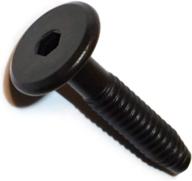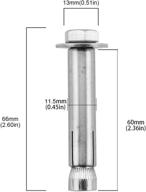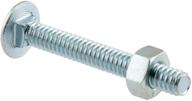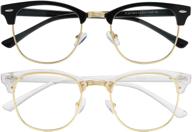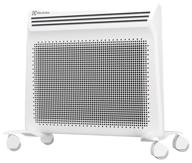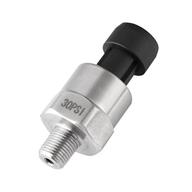Another interesting products
What You Need to Know About Threaded Rods and Studs
Threaded rods and studs are versatile fasteners used in a wide variety of home improvement, construction, industrial, and manufacturing applications. Here's what you need to know about working with these important hardware components.
The Difference Between Threaded Rods and Studs
While they appear similar, threaded rods and studs serve different purposes:
- Threaded rods are designed to span openings and act as an adjustable coupler or tension member. They have male threads on both ends and are flexible, allowing bending.
- Studs are designed to be fixed in place and receive a nut on one end. They have male threads on one end and a head on the other end, limiting flexibility.
Common Uses
Some typical uses for threaded rods and studs include:
- Securing wood framing and connections
- Hanging pipes, cables, and conduit
- Anchoring machinery and equipment
- Bracing trusses and steel frames
- Acting as an adjustable coupler rod
- Providing an embedded anchor point in concrete
Materials and Coatings
Threaded rods and studs come in a range of materials like:
| Material | Features |
|---|---|
| Stainless steel | Corrosion resistance, high strength |
| Galvanized steel | Corrosion resistance on a budget |
| Carbon steel | High strength, low cost |
| Brass | Corrosion resistant, softer material |
Specialty coatings like zinc plating or weather resistant finishes are also available.
Top products in 🧱 Threaded Rods & Studs
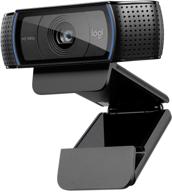

83 Review



3 Review

Sizing Considerations
Threaded rods and studs come in different diameters and lengths. Choosing the right size depends on factors like:
- The loads and forces the fastener needs to withstand
- The spacing between threaded connections
- The size of nuts and openings
When in doubt, consult an engineer or review manufacturer specifications to select adequate threaded rods or studs.
Installation Tips
To install threaded rods and studs properly:
- Use nuts and washers designed for the rod diameter and thread pitch
- Allow extra length for adjustment and tensioning
- Secure the stud base firmly with the right anchors or adhesive
- Use thread sealant for a tighter fit in tapped holes
- Check for full engagement of threads in nuts
With the right selection and installation, threaded rods and studs will provide reliable structural connections and tension members.
Introduction to Threaded Rods and Studs
Threaded rods and studs are two of the most versatile and widely used fasteners in construction, manufacturing, and industrial applications. Though they appear similar, there are some key differences between these important hardware components.
What Are Threaded Rods?
Threaded rod, also known as all-thread rod, is a fastener characterized by:
- Male threads extending along the full length of the rod
- No head on either end
- Ability to bend and flex
- Adjustment capacity by tightening nuts at either end
Common materials include stainless steel, galvanized steel, carbon steel, and brass. Threaded rod is available in different diameters and lengths to suit specific applications.
Similar products
What Are Studs?
Studs are similar to threaded rods but with a few key differences:
- Male threads on one end and a head on the other end
- Designed to be fixed in place, not bent or flexed
- Usually threaded fully or partially into a tapped hole
- A nut then fastens onto the protruding threaded end
Studs are made from similar materials as threaded rods. The head shape and style varies - hex, square, flat, round, and more.
Common Applications
Here are some of the many uses for threaded rods and studs:
- Securing wood connections and framing
- Hanging mechanical equipment
- Anchoring into concrete or masonry
- Acting as an adjustable coupler rod
- Providing flexibility in pipe runs
- Bracing trusses, steel frames, and pole buildings
Sizing and Specifications
Choosing the right threaded rod or stud depends on factors like:
- Required load capacity
- Spacing between connections
- Diameter of holes and openings
- Corrosion resistance needs
With so many sizes and varieties available, consulting manufacturer specifications is key to selecting adequate fasteners.
Proper Installation
To install threaded rods and studs correctly:
- Allow extra length for adjusting nut tension
- Use proper thread engagement into nuts
- Secure stud bases with anchors or epoxy
- Check for full tightening and load testing
With proper selection and installation, threaded rods and studs provide secure, reliable, and adjustable fastener connections in almost any setting.
Common Uses and Applications of Threaded Rods and Studs
Threaded rods and studs are incredibly versatile fasteners used in many industries and settings. Here are some of the most common ways these components are used.
Construction and Framing
In construction projects both large and small, threaded rods and studs join and secure structural elements like:
- Wood framing and block walls
- Concrete forms and footer anchors
- Steel I-beams, rebar mats, and columns
- Roof trusses, rafters, and bracing
Their adjustability makes them ideal for creating structural connections even across changing dimensions and tolerances.
Hanging Mechanical Equipment
From HVAC components to pneumatic conveyors, threaded fasteners securely hang heavy mechanical equipment by providing fixed anchor points. Some examples include:
- Pipe runs and conduit
- Ductwork, fans, and dampers
- Electrical cable trays and busway
- Pumps, compressors, and tanks
Industrial Machinery and Manufacturing
Studs form strong, reusable mounting points for attaching components in manufacturing settings. Threaded rods allow precision adjustment and alignment of equipment like:
- Conveyor systems
- Robotics and automation
- Material handling frames
- Assembly jigs and fixtures
Transportation Infrastructure
High-strength threaded rods help connect critical transportation infrastructure such as:
- Highway signage and signals
- Bridge cable stays and trusses
- Traffic light poles and mast arms
- Rail switch machines and track connections
Proper selection and installation ensures these safety-critical fasteners withstand heavy loads and vibration.
Securing Concrete Formwork
Embedded studs and post-installed anchors with threaded rods secure temporary concrete forms and provide permanent connection points in cured concrete.
In these and many other applications, threaded rods and studs provide the adjustable, heavy-duty fastening capacity that industrial projects require.
Different Types and Sizes of Threaded Rods and Studs
Threaded rods and studs come in a wide variety of types and sizes to suit different applications and requirements. Here is an overview of the main options available.
Threaded Rod Types
Common threaded rod varieties include:
- All-thread - male threads entire length
- Double-end stud - threads on both ends, non-threaded middle
- Bent rod - for adjustable bracing at angles
- Extension rod - extra long lengths for spanning gaps
Rods come in different materials like stainless steel, galvanized steel, carbon steel, and brass.
Stud Types
Stud types are defined by attributes like:
- Head shape - hex, square, round, flat head
- Thread finish - full or partial thread
- Body type - threaded full length or swaged/straight shank
Heavy hex head and full thread studs are common for industrial uses. Headless studs are also available.
Diameter Sizing
Common diameters for threaded rods include:
- 1/4"-3/4" - light duty applications
- 1"-1 1/2" - heavy framing and hardware
- Over 2" - major construction and infrastructure
Stud diameters generally range from 1/4"-2".
Length Options
Lengths for stock threaded rods can be found in:
- 3" to 5" increments up to 10 feet - common lengths
- 12" to 20" increments up to 30 feet - long lengths
Need a custom size? Many manufacturers can cut rods to your exact specifications.
Material Grades
Higher grades offer improved strength but cost more:
- Grade 2 - basic commercial quality
- Grade 5 - stronger for industrial uses
- Grade 8 - premium high-strength steel
With the wide range of types and sizes available, you can find threaded rods and studs suited for just about any heavy-duty fastening need.
Materials for Threaded Rods and Studs
Threaded rods and studs are manufactured from a range of metals and alloys. The material determines properties like strength, corrosion resistance, and cost.
Stainless Steel
Stainless steel rods and studs provide:
- Excellent corrosion resistance
- High strength for structural applications
- Suitable for outdoor and wet environments
Most common is 304 and 316 grade stainless, but high-strength exotic alloys are also available.
Galvanized Steel
Galvanized steel features a zinc coating to resist rust and corrosion. Benefits include:
- Good corrosion protection
- Low cost alternative to stainless
- Often used in exterior construction
Hot-dip galvanizing offers the heaviest coating thickness for maximum protection.
Carbon Steel
Non-coated carbon steel provides:
- High tensile strength
- Standard option for interior uses
- Cost-effective material
Common grades include medium carbon SAE J429 and high strength SAE J995.
Brass
Brass threaded rods feature:
- Excellent corrosion resistance
- Attractive gold coloring
- Softer material less prone to breaking
Best suited for lightly loaded applications rather than structural joints.
Other Materials
More exotic materials like copper, bronze, and aluminum are also used. Plastics can be threaded but are avoided for structural connections.
Choosing the optimal material helps ensure threaded rods and studs resist corrosion while providing adequate strength at a reasonable cost.
Amazon Prime Terms of Use
The Amazon Prime Terms of Service prohibit sharing benefits with individuals beyond your household. Accounts found abusing Prime benefits like free shipping may be subject to cancellation without refund.No Resale Value
The free 2-day shipping included with Prime has no resale value if you are not the end user. You cannot charge extra for this service if reselling Prime-purchased items.High Volume Purchases
Frequently purchasing large quantities of threaded rods or other products through Prime to ship at a lower cost could appear as abuse of the membership. This risks account flagging and cancellation.Better Options for Businesses
If regularly purchasing threaded rods for business use, consider a commercial Amazon Business Prime account. This offers benefits tailored to companies, like bulk discounts and payment options.Or establish accounts with threaded rod suppliers to inquire about discounted bulk/volume pricing and free shipping offers on large orders.Focus on Real Customer Value
Rather than attempting to profit from Prime itself, focus on providing great products, service and real value. This will build genuine customer satisfaction and loyalty over the long term.The bottom line: Abusing an Amazon Prime membership for commercial gain violates the terms and simply won't provide lasting value for your threaded rod business. There are better options to truly help your customers.p>Screw And Fastener
A screw and a fastener are both types of hardware used to join two or more objects together. However, there are some differences between the two. A screw is a type of fastener that has a helical structure and is designed to be driven into a material, such as wood or metal, using a screwdriver or drill. A fastener, on the other hand, is a general term that refers to any type of hardware used to join two or more objects together. Threaded rods and stud bolts are two types of fasteners that are widely used wherever a fastener of greater length and rigidity is needed to secure two items together. Threaded rods are similar to bolts, but they have threading on both ends, while bolts only have threading on one end. Stud bolts are designed to be used in applications where two components need to be joined together. The allowable tensile force for a non-undercut threaded rod is defined by the American Institute of Steel Construction (AISC). Threaded rods are used extensively in the construction industry, as well as in other industries where tension is applied.
Threaded Rod Price
Threaded rod prices can vary depending on the material, length, and quantity purchased. Here are some examples of threaded rod prices from various retailers:
It's important to note that prices can vary depending on the retailer, location, and other factors. It's always a good idea to compare prices from multiple sources before making a purchase.





